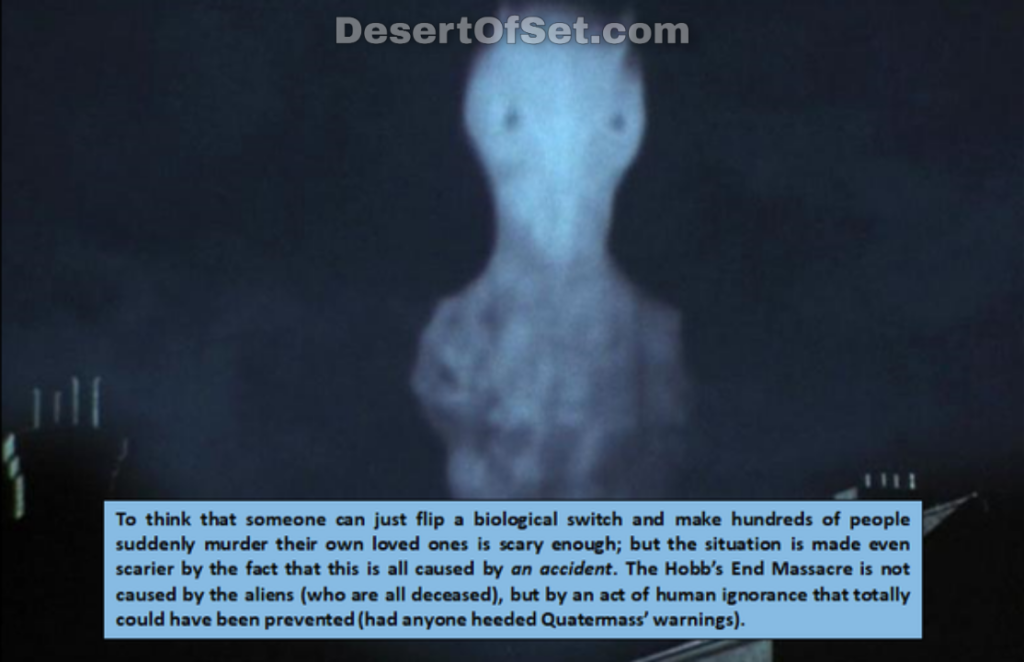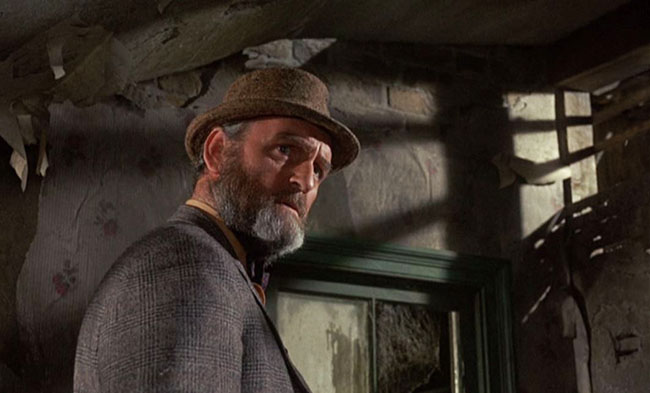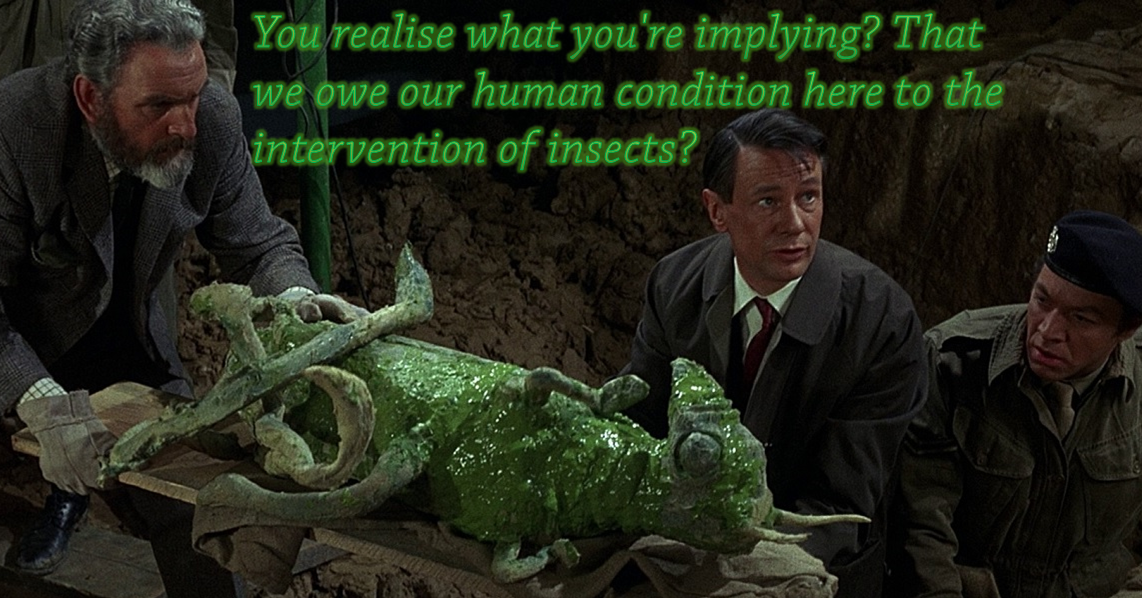Martian grasshoppers. Genetically modified super-apes. Invisible forces only certain people can see. Quatermass and the Pit (1967) has it all.

I love those old Hammer horror films from the 1960s and 1970s: the ones with Christopher Lee and Peter Cushing, filmed in vivid Technicolor, with some of the most atmospheric set pieces you’ll ever see on screen. Hammer revamped all the traditional gothic horror film monsters, and they weren’t afraid to use gallons of blood in the process (which really pissed off the British censors at the time, even though the gore looks pretty fake by today’s standards). They turned Dr. Frankenstein (portrayed by Peter Cushing) into a psychopathic killer who prefers to get the parts for his monsters fresh (if you know what I mean, and I think you do). They turned Count Dracula (Christopher Lee) into a frothing-at-the-mouth sexual predator who can break mere men in half with his pinky finger. They also cast some of the most beautiful demigoddesses to have ever graced this earth. (Seriously, these ladies make their Victorian costumes look more provocative and exciting than even the skimpiest of modern beach attire.) Whether we are addressing The Evil of Frankenstein (1964), Dracula: Prince of Darkness (1966), or even The Devil Rides Out (1968), Hammer films are fucking awesome and warrant multiple repeated viewings.

If I had to choose just one Hammer film as my personal favorite, it would not be easy; but surely Quatermass and the Pit (1967, also known as Five Million Years To Earth) would be counted among my Top Five. This is a sequel to an earlier 1955 film called The Quatermass Xperiment and its immediate 1957 successor, Quatermass II. All three movies are theatrical adaptations of TV serials that were originally broadcast on the BBC in the 1950s. These serials were written and created by Nigel Kneale, who is also known for writing The Abominable Snowman of the Himalayas (1957), The Stone Tape (1972), and the original screenplay for Halloween III: Season of the Witch (1982). Kneale was a fantastic science fiction writer whose work fits rather nicely with the likes of H.P. Lovecraft, and he has been a major inspiration to such horror maestros as John Carpenter and Stephen King, whose Prince of Darkness (1987) and The Tommyknockers (1987) are both directly inspired by Quatermass and the Pit.
The Quatermass films are named for their main character, Professor Bernard Quatermass, a British rocket scientist who contends with various alien forces that seek to wipe out the human race. (In many ways, the original serials also provided a great deal of inspiration for Doctor Who.) Of the trilogy, Quatermass and the Pit is easily the best; and despite being the third film in sequence, it is written in such a way that you don’t have to view either of its predecessors to understand the characters or plot. All you really need to know going in is that it’s about a small British town called Hobb’s End (which should sound familiar to anyone who enjoys John Carpenter’s In the Mouth of Madness). Some subway workers uncover a bunch of weird fossils and an object that looks like an unexploded bomb from the German air raids during World War II. This was not an uncommon problem in England in the 1960s (hell, it’s still a problem today), so panic immediately ensues, and the military is called in to investigate. But it is soon determined that the excavated object is not a bomb after all, and that’s when Professor Quatermass is called in.
Quatermass discovers that the object is actually a spaceship, and that it contains a couple of ancient alien corpses. (The aliens look like man-sized grasshoppers.) The weird fossils that were discovered close to the ship appear to have been primates that the aliens were using as experimental test subjects. Quatermass also learns that Hobb’s End has been subject to all manner of paranormal disturbances since time immemorial; whenever someone disturbs the ground where the spaceship now rests, ghost and hauntings are soon reported throughout the surrounding area. And when a man accidentally scrapes the spaceship with a wrench, it causes all these weird telekinetic phenomena to start happening.

Quatermass figures the aliens are from Mars, and that they came to colonize the Earth before humans evolved. He thinks they planned to transfer their consciousness to the ancient primates they found, so that they could live more comfortably in our ecosystem. But something went wrong, and the aliens all died. Yet the super-apes they created survived, and some people today are actually descended from them. Such people tend to be born with weird psychic abilities, and Quatermass theorizes that this may be where all our legends of magic and witchcraft come from. The aliens even resemble Satan, with tiny horns poking out of their skulls. But there’s just one problem: even though the aliens and their super-apes are dead, the powers they evoked continue to exist in human beings today, and the alien spaceship is still functional. Quatermass fears that if anything is done to disturb the vessel, it could re-awaken the dormant Martian hive consciousness that resides within every person who is descended from the modified apes. And this is exactly what happens when the British government decides to hold a big press conference at the excavation site. Some knucklehead drops some live electrical wiring on the ship, and it wakes up.

The awakening of the Hobb’s End spaceship is one of the most terrifying sequences I’ve ever seen in any horror film. Approximately half the local population is suddenly possessed by the Martian hive mind, which then drives them to murder all their neighbors, co-workers, and families. These people even kill all the animals they encounter as well; there’s one ghoulish moment when we hear them slaughtering a bunch of cats and dogs outside, and it never fails to make my blood run cold. To think that someone can just flip a biological switch and make hundreds of people suddenly murder their own loved ones is scary enough; but the situation is made even scarier by the fact that this is all caused by an accident. The Hobb’s End Massacre is not caused by the aliens (who are all deceased), but by an act of human ignorance that totally could have been prevented (had anyone heeded Quatermass’ warnings).
The heroes end up using a big iron crane to discharge the Martian spaceship’s energy back into the Earth. As in a great deal of folklore, it is the apotropaic power of iron (a substance most sacred to Set) that dispels the forces of evil in the end. But unlike most other science-fiction/horror films from this period, Quatermass and the Pit does not conclude with the male and female survivors hugging and kissing each other like everything’s going to be all right. Here, Professor Quatermass and his friend Dr. Judd (played by Barbara Shelley, my favorite Hammer glamour girl) are left standing alone amidst a sea of urban ruin, not breathing a word to each other. They’re too frightened to even look at each other, much less touch. (Perhaps they fear that doing so might spark up the Martian hive mind again?) They just stare fearfully into the night, forever traumatized by what they’ve seen and experienced. Roll credits!
One sure way to make me want to read a story or watch a film is by telling me, “It’s horror AND science fiction.” Some of my favorite films fall into this category, including Ridley Scott’sAlien (1979) and John Carpenter’sThe Thing (1982). But Nigel Kneale’s work is distinct because it combines science fiction with supernatural horror, using science to plausibly substantiate the paranormal (rather than dispelling it). The genealogical descent of all witches and wizards from Martian-engineered apes is just one example. Another would be the concept behind The Stone Tape, in which Kneale has scientists discovering that “ghosts” are actually residual “recordings” of past events that have been embedded into certain rocks. (This hypothesis is now called “the Stone Tape Theory,” which still carries considerable weight among paranormal researchers today.) And of course, Halloween III: Season of the Witch proposes that the mineral content of Stonehenge is catastrophically dangerous and can actually be weaponized by any corporation with the necessary know-how. As far as I’m concerned at least, Nigel Kneale belongs in the same company as such hard science fiction masters as Isaac Asimov and Arthur C. Clarke.

In Quatermass and the Pit, the Christian concept of “the devil” is revealed to be nothing more than a genetic race memory of the Martian colonists who experimented on our primate ancestors. These aliens were not necessarily “evil,” either; they were simply doing what they could to survive. As a Setian, the idea that “Satan was originally something else, and it wasn’t evil” has been a very old recurring theme in my life. And the idea that a sufficiently advanced or “magical” technology can be misused to wreak unspeakable havoc is also familiar, given what I have seen when ill-prepared occultniks fuck around with things like qliphoth or the Simon Necronomicon. Finally, I can identify with the idea of there being a scientific basis for “superstitions” like the use of iron objects to execrate evil spiritual forces. Indeed, Quatermass and the Pit is not only scary, but incredibly thought-provoking for anyone who takes an interest in the esoteric side of life. For Pagans and witches, I really can’t recommend it highly enough.
